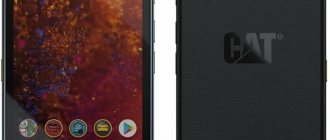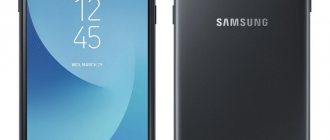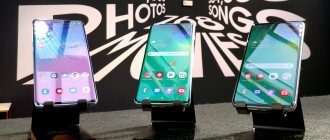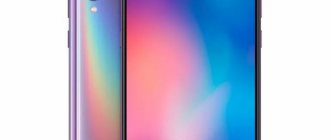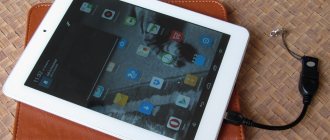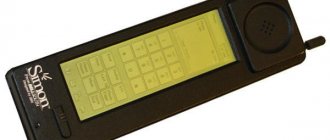Desktop vs Application Menu
When you turn on “naked” Android for the first time, you are amazed by the cleanliness of your desktop: only the essentials are on it.
In fact, it plays the role of a huge quick access panel - or, if you want, a complete analogue of the Windows Desktop. A complete list of applications is available in the “Menu”: here you will find system utilities, shortcuts to access parametric settings, and each of the installed programs. Everything is sorted alphabetically.
The MIUI developers initially chose a different approach for their shell, familiar to all our readers: dump everything en masse on the desktop, then figure it out yourself.
Yabloko members claim that this is more convenient. “Xiaomists” echo that you can create several desktops, convenient folders, put unnecessary things in one place away... And so on.
What is Android One?
Android One is a low-cost line of consumer electronics devices that runs the Android operating system.
It is a hardware and software standard created by Google for the Android OS and customers in the developing world, although it was later also made available in a limited form in some developed countries.
Google manages the design, development, marketing and support of these devices, while all manufacturing is carried out by partner Original Equipment Manufacturers (OEMs).
Android One smartphones run on software close to “pure Android”, i.e. without user interface settings. Foreign developers call this version “stock Android”; in the Russian-speaking environment they like to say “naked Android”.
Pure Android on Xiaomi Mi A1 works without the usual MiUI shell. Security and system updates are handled by Google, avoiding the problems of missing security updates that plagued earlier phones.
Curtain: custom or standard?
The second difference between the two systems catches your eye even earlier than the application menu. The curtain in Android allows you to place a limited number of applications, and in the simplest versions it does not allow you to edit it.
Slightly more advanced “pure” AOSP shells allow you to remove or add a couple of icons to quickly launch Bluetooth or SIM card settings. But you can’t add something of your own from deep within.
MIUI is another matter. The seventh version offered an almost endless carousel that could accommodate any quick launch shortcuts.
Now the carousel has been replaced by a standard curtain, but its maximum size is limited only by the screen size. And the choice is much wider - including due to shortcuts to those settings that are not in AOSP.
Xiaomi Redmi Go 1/8GB
An ultra-budget smartphone that runs on Android Go, a version of the operating system designed for smartphones with no more than 1 GB of RAM.
What does the buyer get? Nice body design, 5-inch display with a resolution of 1280x720 pixels, two single cameras (front and rear), Qualcomm Snapdragon 425 processor, 1 GB of RAM and 8 GB of ROM, 3000 mAh battery.
Of course, there is no talk of any fingerprint scanner or NFC module.
- Screen diagonal: 5 inches
- Screen resolution: 1280×720
- Weight: 137 g
- Number of SIM cards: 2
- Processor: Qualcomm Snapdragon 425
- Memory capacity: 8 GB
- RAM capacity: 1 GB
- Battery capacity: 3000 mAh
- Rear camera: 8 MP
- Front camera: 5 MP
- Memory card support: yes
Security restrictions
Security is interestingly organized in two versions of one system. AOSP requires you to enable “Developer Mode”, after which any actions are possible after confirmation. Sometimes, for major changes, you don’t even need root rights (administrator rights to write to system folders).
MIUI behaves in a similar way. But any program, except the actual Google and Mi applications, is installed with disabled access rights.
This results in less advanced users being unable to use many features. Bad idea?
Excellent, because in MIUI the set of rights is seriously expanded, for example, network access via Wi-Fi, via 4G and in roaming - these are 3 different switches.
And in addition to the actual access rights to resources, the operation of each application is regulated by general rules for working with system resources.
Working with memory
Unless the user has set otherwise, only 2 types of applications can currently occupy memory: system and active with an open and active window.
All others are unloaded from memory as soon as another program is opened on top. “Cleaning memory” on the main screen even unloads services. Need background work? You need to set the appropriate permissions.
All this is very different from AOSP, which allows any programs and services to hang around in memory as long as they want, consuming resources. There is only one limitation - the simultaneous number of running processes must fit into 50.
Performance
Shells installed on top of Android may have their own graphic effects and various services that provide additional load on the device’s resources. Most often, this results in a lack of RAM, which you will constantly remember when working with heavy applications.
In some shells, to solve the problem, the function of unloading demanding tasks from the background is activated by default. Once you take a break from your favorite shooter by opening, for example, a browser, after a while you will have to launch the game again.
Working with the battery
MIUI behaves approximately the same way in terms of battery consumption. Do you want the messenger to consistently send notifications and work in the background? Don't forget to turn off battery saving mode for it.
In the stock MIUI battery manager, you can set several levels of limiting battery consumption by applications:
- do not limit
- limit when consumption exceeds the background,
- limit the application itself in the background and leave the service active (relevant for instant messengers),
- close the application completely.
Of course, nothing like this can happen in bare Android AOSP.
Available or blocked bootloader
The only way to bypass such restrictions for an application is to install it in the boot area. But if the usual AOSP most often offers open access to it through the system bootloader, MIUI completely blocks access to it.
Do you need to flash third-party firmware? You need to get permission to unlock the bootloader, connect your smartphone to your computer and pray that the Chinese servers are available.
At the same time, it will be quite difficult to deceive some Sberbank, which checks the “cleanliness” of the system area of the drive - most likely, it will stop working.
On the one hand, this is bad, and for an experienced user it only brings additional problems. On the other hand, native Xiaomi firmware works stably and rarely requires intervention. And you won’t need an antivirus, as in the joke about viruses in Linux: it will have to manually set all permissions.
AOSP, on the contrary, with its bootloader open by default, is a complete security hole even for applications from the Google Store.
Child mode and other protection methods
Although every Android smartphone has a fingerprint scanner, its capabilities in the stock operating system are limited to unlocking the screen.
MIUI also offers to block access to any application using a fingerprint, right down to the system settings menu.
If this is not enough, you can use the “Children's mode”, in which you have access only to designated programs, and access to the general system is possible only after unlocking - including with a fingerprint.
Top 7 Android One smartphones
Reward accrued
This material was written by a site visitor and was compensated for.
A few years ago, Google announced the launch of the Android One project. Its goal is to popularize the stock version of the Android OS. True, despite the lack of proprietary OEM software on top of Android, the version of the OS installed in Android One smartphones is different from the operating system used in the Google Pixel.
The Android One project produces mainly budget models, but there are also several interesting solutions on this list, including a couple of Nokia flagships. We will talk about them, as well as five other smartphones, below.
announcements and advertising
2080 Super Gigabyte Gaming OC for 60 rubles.
Compeo.ru - the right comp store without any tricks
RTX 2060 becomes cheaper before the arrival of 3xxx
Ryzen 4000
series included in computers already in Citylink
The price of MSI RTX 2070 has collapsed after the announcement of RTX 3xxx
Core i9 10 series is half the price of the same 9 series
The price of memory has been halved in Regard - it’s more expensive everywhere
In the fall of 2020, as part of the expanded Android One program, the Xiaomi Mi A1 model premiered. It has become one of the most popular smartphones from the Chinese manufacturer, but over more than two years, several much more interesting devices have appeared on the market. One of them is Xiaomi Mi A2.
The smartphone is equipped with a 14nm Snapdragon 660 chip paired with 4/6 GB of RAM. Built-in storage capacity ranges from 32 GB to 128 GB, depending on the configuration. Xiaomi Mi A2 stands out with its all-metal body. Under the hood of the device there is a 3000 mAh battery, which is one of the weak points of the model.
Xiaomi Mi A2 has a 5.99” LCD screen with a resolution of 1080p on the smaller side. There is no notch in the display, and the 20 MP front camera is located in the indent at the top of the front part. The back of the smartphone contains a dual main camera with a resolution of 12 MP + 20 MP. The Mi A2 was the company's first smartphone without a headphone jack. The 4/64 GB version is available in the official store in Russia at a price of 21,990 rubles.
Another Xiaomi device, the Mi A3, runs on the bare version of the Android OS. It was released in the middle of last summer. The model is equipped with a 6.01-inch OLED screen with an integrated fingerprint sensor and HD+ resolution. The battery capacity is 4030 mAh.
Under the hood of the Xiaomi Mi A3 there is an 11nm single-chip Snapdragon 665 system paired with 4/6 GB of RAM. The permanent storage capacity is 64/128 GB. Unlike its predecessor, the third generation model received both a memory card slot and a Mini-Jack.
The smartphone has a 32-megapixel selfie camera. The main camera in the device is represented by a trio of modules: a universal 48 MP, an additional 2 MP and a wide-angle 8 MP. The official cost of the 4/64 GB and 4/128 GB modifications in Russia is 14,990 rubles and 16,990 rubles, respectively.
Motorola also has several smartphones with stock versions of the Android OS. We will only pay attention to a couple of models based on a mobile processor from Qualcomm. The remaining devices received single-chip systems Exynos from Samsung and Helio from MediaTek.
The first model is Motorola One Zoom. It is equipped with a four-module main camera. Its main component, as the name suggests, is an 8-megapixel telephoto lens with 3x optical zoom and optical stabilization. The resolution of the main module is 48 megapixels, the wide-angle one is 16 megapixels, and the secondary one is 5 megapixels.
The 25 MP front camera is installed in a drop-shaped cutout at the top of the OLED screen. The display has a diagonal of 6.39” and FHD+ resolution. A fingerprint sensor is installed under the screen to unlock the smartphone and confirm banking transactions.
The Motorola One Zoom is based on the Snapdragon 675 mobile processor, made using 11-nm technology. The smartphone is offered in only one configuration – 4 GB RAM + 128 GB ROM. The battery capacity is 4000 mAh. This model, unlike the two Xiaomi devices, has an NFC chip. The cost of a smartphone in Europe is 400 euros.
The second model Motorola announced as part of the Android One initiative is called the Motorola One Hyper. This is a new smartphone. Its announcement took place last week. The device, like the One Zoom, is equipped with a Snapdragon 675 chip paired with 4 GB of RAM, and the storage capacity is 128 GB.
Motorola One Hyper is distinguished by the presence of a 64-megapixel sensor in the main camera and support for 45-watt fast charging. True, only the American version of the new product can boast of the latter. A modification with 27 W fast charging will be sold in Europe. The cost of the model in the USA was $400.
The device received a 4000 mAh battery and an NFC chip. The display has a 6.5" diagonal and FHD+ resolution. It is based on an LCD panel, and a fingerprint sensor is installed on the right side. In addition to the main 64 MP module, the main camera has an 8 MP wide-angle one. The selfie camera resolution is 32 MP. It is installed on a retractable mechanism and hides inside the case when it is not needed.
If Motorola takes quantity, then Nokia does not forget about quality. The brand’s assortment also includes many smartphones running stock OS from Google, however, they attract much more attention than devices from the American brand owned by Lenovo. One of these is last year’s flagship, Nokia 8 Sirocco.
The model acquired a Snapdragon 835 chip, made using 10nm technology. The chipset is complemented by 6 GB of RAM. A 128 GB drive is installed for data storage. Power is provided by a not very capacious battery - 3260 mAh. But fast charging technology is announced according to the Quick Charge 4 standard. Moreover, there is even wireless charging.
Nokia 8 Sirocco has a 5.5-inch P-OLED panel. The resolution is 2K, and the aspect ratio is 16 to 9. There is no headphone jack in the smartphone. The main camera in the flagship is dual. The main module is represented by a 12 MP sensor, and the telephoto lens is based on a 13 MP matrix. The selfie camera resolution is 5 MP.
Earlier this year, HMD Global, which owns the rights to the Nokia brand, introduced another flagship smartphone within Android One. It is called Nokia 9 PureView and is distinguished by a five-module main camera, the resolution of each sensor in which is 12 megapixels. Moreover, three of them are black and white. The selfie camera has a resolution of 20 MP.
The flagship is equipped with the Snapdragon 845 chip, which was used in the top devices of 2020. There is 6 GB of RAM and 128 GB of flash memory. The capacity of the built-in battery was 3320 mAh.
The February news was left without a microSD slot and a headphone jack. But it has an NFC chip and supports wireless charging. The P-OLED panel received FHD+ resolution. The diagonal is 5.99". Nokia 9 PureView costs 49,990 rubles in Russia.
The last model that we will pay attention to is called Nokia 8.1, also known as Nokia X7. The smartphone borrows the dual main camera from the Nokia 8 Sirocco. But the front camera turned out to be more advanced. She got a 20-megapixel 1/3” format matrix with a pixel size of 0.9 microns.
The Nokia 8.1 is based on the Snapdragon 710 processor, made according to 10-nm technology. The smartphone offers users up to 128 GB of ROM and up to 6 GB of RAM. The capacity of the built-in battery was 3500 mAh.
Nokia 8.1 became the latest smartphone from the brand to feature a display with a wide notch. In the future, it was replaced by a teardrop-shaped neckline. The screen is built on an FHD+ LCD panel with HDR10 support. The diagonal is 6.18".
Dual space and dual applications
For those who like to experiment, MIUI offers one more feature: an additional desktop in which additional applications or their clones will live.
Do you need to install an unstable beta version of the program? Installing in Extra Space will limit its impact on the system. If something doesn't go according to plan, you can completely clear this area on the drive.
For several accounts in one application, Xiaomi offered a system utility, the functions of which in AOSP are assigned to third-party software: duplication of installed programs.
Each one uses its own settings. So this is a real godsend for SMM specialists, for example: after each one you can duplicate it with a third-party program, and on one smartphone you can spin a bunch of accounts for free.
Pros and cons of Android One phones
1. The fastest updates. Devices on a bare system do not depend on manufacturers' shells and therefore are the first to immediately receive updates. On other mobile phones, where modified firmware with third-party launchers are installed - for example, MIUI from Xiaomi, it may take several months until the manufacturer adjusts its shell to the new version of the system.
2. The battery is consumed less. Since the system is clean and there are no third-party applications, there are fewer processes hanging in the processes that consume energy.
3. More performance and hardware. Smartphones in this line come with mid-top hardware and are characterized by high speed of operation and completion of tasks. Which is quite interesting, because at first it was planned to produce public sector phones under this brand.
4. Less advertising. Companies often insert a lot of advertising into their shells. There is no such thing here.
5. Better customization. Install what you want yourself, any launcher and software - there is no imposed software from the manufacturer.
6. The best camera. Companies that produce smartphones in this line try to install cameras on them that take photographs of excellent quality, so when purchasing such a device you can be sure that the pictures will be excellent.
The only downsides are individual preferences in the hardware of such devices and whether you like a clean OS. Otherwise, everything is essentially the same, except that support is realistic for eighteen months.
Interface scaling
Unfortunately, "pure" stock Android only allows the user to change the wallpaper, screen gamma and font size, and enable screen gestures for quick access to applications and functions.
In MIUI you can customize everything: font size and type; change the purpose of hardware and touch buttons, introduce additional functions on them; assign the behavior of the LED indicator.
However, screen gestures are limited to tapping and 2-3 finger combinations (versus the alphabet in AOSP). On the other hand, MIUI is much more convenient for users who are accustomed to small screens.
In addition to scaling fonts, she suggests using a slide to switch the interface into a tiny window of 3.5-4 inches or enable a mode with huge shortcuts that turn the smartphone into something like a “grandmother’s phone.”
Nokia 2.2 16GB Android One
Another inexpensive device from Nokia based on Android One. It has several interesting features: a separate mechanical button for calling the Google Assistant, as well as the ability to replace the back panel. Panels are sold separately.
The screen has a diagonal of 5.71 inches, the processor is MediaTek Helio A22, the memory capacity is 16 GB of ROM and 2 GB of ROM, the main camera is single, the battery capacity is 3000 mAh. There is no fingerprint sensor, but face unlock is supported.
- Screen diagonal: 5.71 inches
- Screen resolution: 1520×720
- Weight: 153 g
- Number of SIM cards: 2
- Processor: MediaTek Helio A22
- Memory capacity: 16 GB
- RAM capacity: 2 GB
- Battery capacity: 3000 mAh
- Rear camera: 13 MP
- Front camera: 5 MP
- Memory card support: yes

